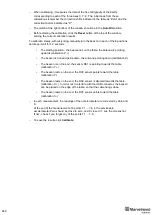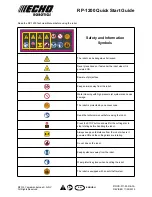
244
11.8. Proper Ultrasonic Signal Detection
This chapter mostly related to HW v4.9 beacons. Super-Beacons, Industrial Super-
Beacons have high-power digital microphones for noise filtering and proper signal
detection. Anyway, if you have problems with signal detection, read this chapter no
matter which beacons do you use
These recommendations suitable only for NIA
Marvelmind Indoor Navigation System uses proprietary multi-frequency for ultrasonic
signal and employs additional filtering to combat external noise. This also makes the
system rather immune against the “usual suspects.” However, if the external noise is
too str
ong, its source is too close, or it’s emitting a strong signal on frequencies close to
19, 25, 31, 37, 45kHz or white noise, the system functionality can be affected.
When external noise is high, identify the source. Usual sources include:
-
Ultrasonic-based volume or movement detection alarm systems
-
Other robots using ultrasonic
-
Parktronics
-
Sources of very strong white or impulse noise (air guns, air press, cutters,
vacuum cleaner, etc.)
-
Rotors of drones/copters
The best things to do in this case:
-
Identify the beacons that are affected. Usually, they are those that are the
closest to the source of noise. Try to reposition them
-
Manually reduce the gain of the affected stationary beacons so that the signal
from the mobile beacon would have a 1000
–1800 amplitude. That would give
the best signal-to-
noise ratio. Don’t make the gain too high. The noise will be
amplified, but the desired signal will be saturated and signal-to-noise ratio will
be poor
-
Input distances between beacons manually. More information
The gain settings may be very non-linear. There is almost no change at 4000 to
3000. But around 2500, the gain starts reducing very quickly (1200
– for some HW
versions). By setting the gain manually, it is possible to find the optimal gain to obtain
the highest signal to noise ratio so the system can work even in very challenging
external conditions.
When the map is formed, only the mobile beacon is emitting, whereas stationary
beacons are not. Thus, it does not matter how close the mobile beacon is to the
source of the noise. However, it matters how close the stationary beacons are to
those sources. Select the positions of the stationary beacons accordingly - place
them further away from the noise sources.
Summary of Contents for IA-04-2D-Badge
Page 1: ...Marvelmind Indoor Navigation System Operating manual v2022_08_24 www marvelmind com ...
Page 21: ...21 Beacon Mini TX Beacon Industrial RX Beacon Industrial TX Metal ...
Page 22: ...22 Industrial Super Beacon Plastic ...
Page 39: ...39 Figure 7 One External Microphone connection Figure 8 Two External Microphone connection ...
Page 44: ...44 Figure 3 One external microphone soldering Figure 4 Two external microphones soldering ...
Page 46: ...46 Figure 7 Two External Microphones final view Figure 8 Two External Microphones final view ...
Page 118: ...118 6 6 28 The system is now fully operational ...
Page 180: ...180 Floor 5 is enabled Floor 4 is enabled ...
Page 190: ...190 Z X ...
Page 207: ...207 Choose color and press OK Color applied Now background matches floorplan ...
Page 214: ...214 9 24 IMU axis positioning Super Beacon IMU axis positions HW v4 9 IMU axis positions ...
Page 215: ...215 Mini TX IMU axis positions Mini RX beacon IMU axis positions ...
Page 219: ...219 Real time player turned on ...
Page 223: ...223 10 2 Beacon HW v4 9 external interface 4x4 pinout top view ...
Page 224: ...224 10 3 Modem HW v4 9 external interface pinout top view ...
Page 232: ...232 If everything done correctly Own IP address will change Static IP settings completed ...
Page 238: ...238 How to change modes Choose hedge Go to Ultrasound TDMA mode Left Click to change ...
















































